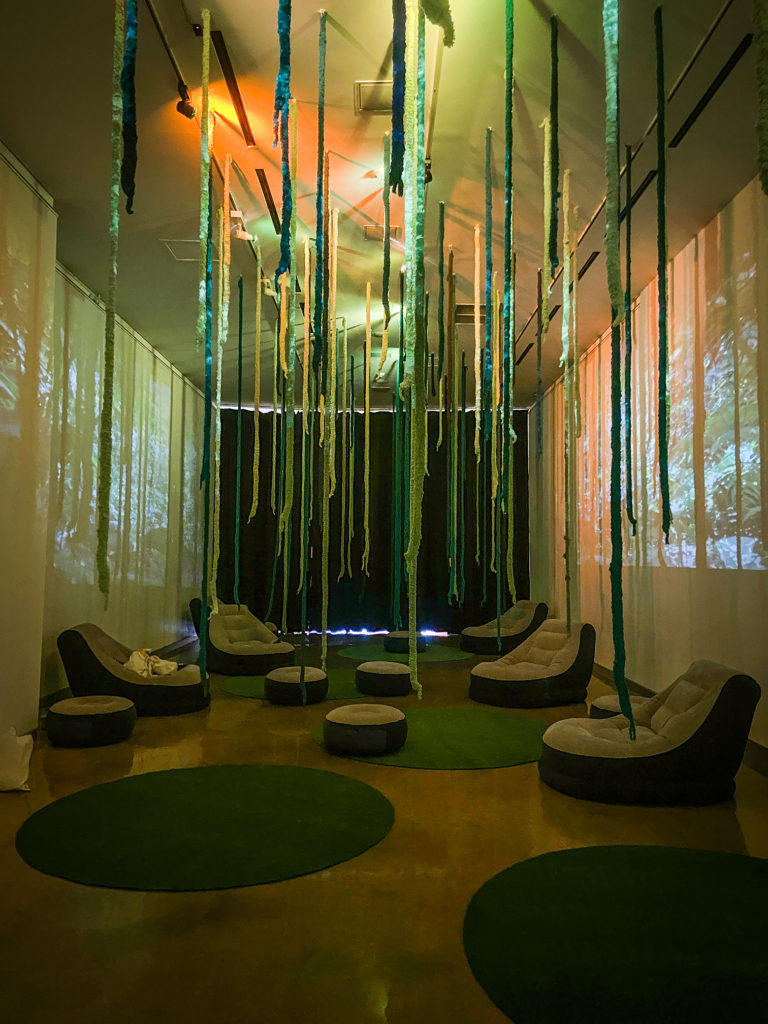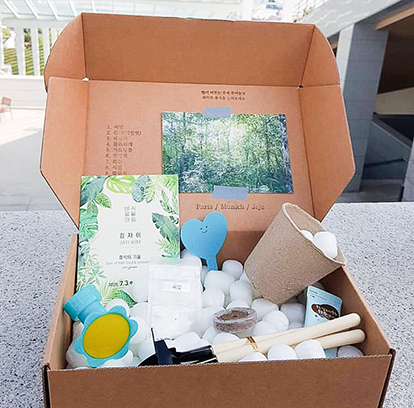Artist Talk in Gwangju: Jayi Kim
Interview by Aekyeong Lee.
Artist Jayi Kim, based in Gwangju, has become known for her artwork, the latest iteration of which is a relaxing space decorated with artificial greenery. However, the message in her art is more complicated than rest and relaxation. Her works reflect her acute awareness of how essential it is for us to look after ourselves and notice the signs our subconscious sends to us.
Her interest in the subconscious increased when she was diagnosed with thyroid cancer while studying for a master’s in art and space at Kingston University in London. She wondered why she had not noticed any symptoms before the disease progressed so far. She thought it might have been because she had not focused enough on her inner self. This made her come to realize that she should have concentrated more on her subconscious. This is the reason why she started trying different methods of introspection, such as keeping a dream journal, thematically analyzing the words she used every day, and rearranging and exhibiting her collections in different themes.

Pursuing the idea of her subconscious being connected to her past experience with cancer, her current work about rest and relaxation is grounded in her intention to stay healthy. As a method of looking after herself, she turned her research focus to rest. She learned of two different types of rest: active and inactive, as well as the therapeutic impact of artificially designed nature on our mind. Based on these findings, she installed an artificial forest in a gallery space with videos and photos of greenery, including artificial stems that she knitted herself. In this room created by the artist’s active rest, the audience experiences inactive rest such as listening to recorded nature sounds and observing scenes from a forest projected on the wall while lying on beanbags.
What is more interesting about her work is that she asks her audiences what they usually do to rest. She gives them plant seeds so that they can experience the artist’s way of rest at home. This exchange between the artist and the audience makes it possible for her art to shape people’s lives directly. In the interest of fostering more of these exchanges, I was fortunate to have a discussion with the artist herself. What follows is our exchange.
Aekyeong Lee (AL): You’ve participated in residency programs in different organizations every year since 2014. How have the experiences in different cities and countries affected your work?
Jayi Kim: I’ve learned that the styles of rest can vary depending on cultural and geographical differences. This is what I’ve been interested in and want to research further in the future.
AL: You’ve been studying the importance of relaxation and various styles of rest. With the knowledge you’ve accumulated, you’ve created the series “Skill of Rest and Relaxation.” Among the works, my favorite is the one where I can lie on a reclining chair, listen to the sounds of nature, and watch moving images of nature. Indeed, this work has drawn great attention from both the public and art museums. Why do you think people love your work?
Jayi Kim: Even before COVID-19, people started thinking about the environment, their well-being, and work–life balance. The public interest in nature and both physical and mental health has increased far more in recent times due to the pandemic. However, it’s still hard for people to find a place in which they can take a break and relax. It seems like my work provides them with what they need.

AL: Your art always requests the audience’s participation. What I love the most about your work is the seed kit that you give the participants to thank them. Through this exchange of how you rest, have you learned any new styles of relaxing? More importantly, what messages do you want to tell the audience?
Jayi Kim: The kits were designed for a group exhibition held in Yeulmaru in Yeosu last month. I’ve become aware of the fact that there are so many different ways to rest through the exchange. On top of that, I hope the participants try out diverse activities for resting rather than stick to a fixed one. You might find a new activity that’s more suitable for you. For example, a friend of mine told me she’d thought online shopping after work helped refresh her, but realized that she got tired afterwards. She said my work gave her a chance to reflect and re-evaluate the way she rested. She was finally able to have a better, more relaxing journey by sharing her way with the other audience members through my work.

AL: In the interview with the Gwangju Museum of Art you said you were preparing for your solo exhibition at the museum, where you are an artist-in-residence at the moment. Could you introduce this upcoming exhibition and your work?
Jayi Kim: The studio provided by the Gwangju Museum of Art is located in the center of a large public park, Gwangju’s Jungoe Park. This park is full of trees and flowers, yet people aren’t free to rest on their own there since it’s an open, public area. Thus, for my solo exhibition, I decided to install a private space filled with natural scenes and sounds for people seeking a space to rest with privacy in nature. They should book their time slot before arrival via my website.
AL: Is there any other project you’re planning to do?
Jayi Kim: In November, there’s going to be a group exhibition held at the Lee Kang Ha Art Museum. It’s a collaborative project with the National Museum of Modern and Contemporary Art. The information about this exhibition will be updated on the website of the Lee Kang Ha Art Museum later. In addition to that, I’d like to compile the responses on the exchange project I’ve been doing and publish a book if I have a chance.

Photographs courtesy of Jayi Kim.
Footnotes:
Yeulmaru (예울마루), a culture and arts park in Yeosu, provides an online tour of this exhibition in which Jayi Kim participated in September. Check the video link and find out more about her art. https://tv.naver.com/v/15362269
A video of the interview (in Korean): https://www.youtube.com/watch?v=0fRlhySTErg
Jayi Kim’s website: http://www.jayikim.com
The website of the Lee Kang Ha Art Museum: http://www.lkh-artmuseum.com/
The Interviewer
Aekyeong Lee is an international residency manager and curatorial assistant at the Gwangju Museum of Art. After earning an MA in art museum studies in the U.K., she started earning an MA in psychology and neuroscience at King’s College London for interdisciplinary research in the museum sphere. With a great interest in hearing from different perspectives, she interviews local artists and art enthusiasts with multidisciplinary viewpoints.
Instagram: @evevievy




